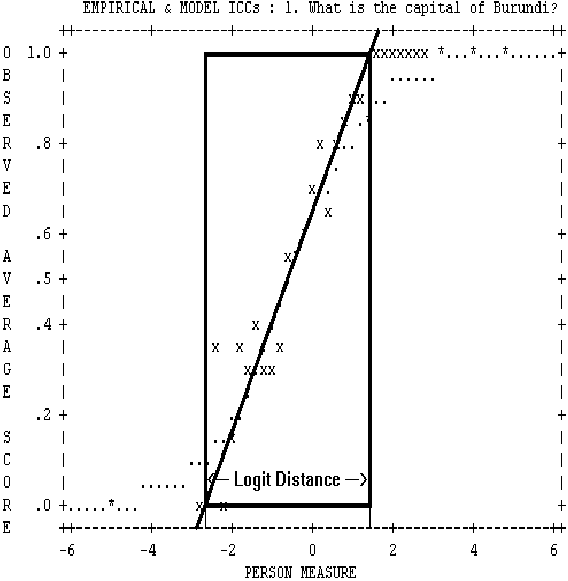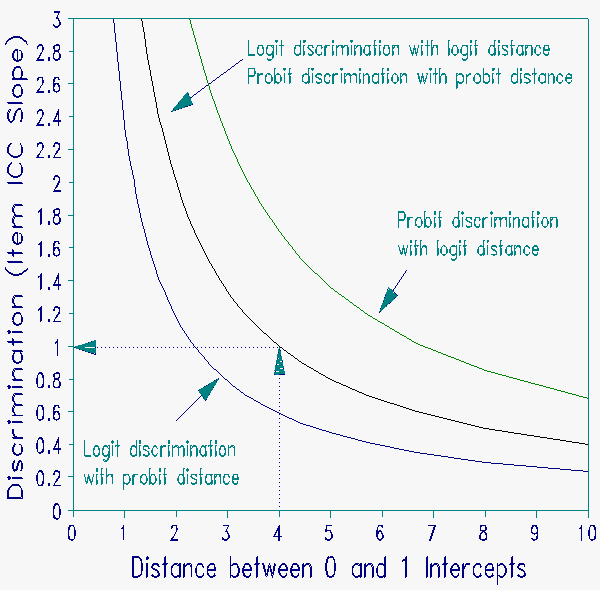
Plots of empirical item characteristic curves (ICCs) enable one to estimate the empirical item discrimination, at least as well as a 2-PL IRT computer program. This is because 2-PL discrimination estimation is degraded by the imputation of a person distribution and by arbitrary constraints placed on discrimination values. It is also skewed by accidental outliers which the eye can disregard.

|
| Figure 1. Empirical and model ICCs. |
On a plot such as Figure 1 draw in the line that, to your eye, matches the central slope of the empirical item characteristic curve (ICC). In Figure 1, the dots indicate the Rasch-model-predicted ICC. The points marked `x' indicate the empirical values, obtained by averaging the observed responses, `0' and `1', for persons whose measures are estimated to be in the .1 logit interval centered on the `x'. When a dot and an `x' coincide, a `*' is shown. The line follows the trail of `x' and `*'.
Estimate the logit (x-axis) distance from where the line intercepts the .0 score value to where it intercepts the 1.0 score value (for dichotomies). The logit distance here is about 4.0 logits.
Use the nomogram in Figure 2 to estimate empirical item discrimination. In this nomogram, looking at the middle traceline, a logit distance of 4.0 logits, corresponds to a logit discrimination of 1.0, in accordance with model prediction. Shorter distances, i.e., steeper slopes, correspond to higher discriminations.

|
| Figure 2. Nomogram for item discrimination. |
In Figure 2, there are 3 lines in order to simplify comparison and reporting of results in an IRT context. 2-PL programs generally report their results in probits. So the probit discrimination for logits distances is given by the upper line. That corresponding to a 4-logit distance is 1.7. On the other hand, if one is looking at plot scaled in probits, instead of logits, one would look at the lower line to find the logit discrimination.
John M. Linacre
Estimating item discriminations with Rasch models. Linacre JM. … 16:1 p.868
Estimating item discriminations. Linacre JM. … Rasch Measurement Transactions, 2002, 16:1 p.868
| Forum | Rasch Measurement Forum to discuss any Rasch-related topic |
Go to Top of Page
Go to index of all Rasch Measurement Transactions
AERA members: Join the Rasch Measurement SIG and receive the printed version of RMT
Some back issues of RMT are available as bound volumes
Subscribe to Journal of Applied Measurement
Go to Institute for Objective Measurement Home Page. The Rasch Measurement SIG (AERA) thanks the Institute for Objective Measurement for inviting the publication of Rasch Measurement Transactions on the Institute's website, www.rasch.org.
| Coming Rasch-related Events | |
|---|---|
| Jan. 16 - Feb. 13, 2025, Fri.-Fri. | On-line workshop: Rasch Measurement - Core Topics (E. Smith, Winsteps), www.statistics.com |
| Apr. 8 - Apr. 11, 2026, Wed.-Sat. | National Council for Measurement in Education - Los Angeles, CA, ncme.org/events/2026-annual-meeting |
| Apr. 8 - Apr. 12, 2026, Wed.-Sun. | American Educational Research Association - Los Angeles, CA, www.aera.net/AERA2026 |
| May. 15 - June 12, 2026, Fri.-Fri. | On-line workshop: Rasch Measurement - Core Topics (E. Smith, Winsteps), www.statistics.com |
| June 19 - July 25, 2026, Fri.-Sat. | On-line workshop: Rasch Measurement - Further Topics (E. Smith, Winsteps), www.statistics.com |
The URL of this page is www.rasch.org/rmt/rmt161m.htm
Website: www.rasch.org/rmt/contents.htm